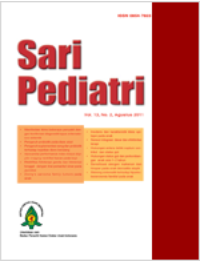Gangguan Koagulasi pada Sepsis
Sari
Sepsis pada anak memiliki angka morbiditas dan mortalitas yang tinggi. Gangguan koagulasi berat pada
sepsis berhubungan dengan meningkatnya mortalitas. Telah banyak informasi mengenai perkembangan
mekanisme aktivasi koagulasi dan inflamasi sebagai respon terhadap infeksi berat. Pada sepsis, gangguan
koagulasi terjadi akibat pembentukan trombin oleh tissue factor, gangguan mekanisme antikoagulan dan
penghentian sistem fibrinolisis. Pengetahuan tersebut sangat berguna untuk mengembangkan terapi dan
intervensi terhadap pasien dengan sepsis yang disertai gangguan koagulasi berat. Pemberian terapi seperti
antikoagulan, antitrombin, dan rekombinan protein C, rekombinan TFPI masih memerlukan bukti yang
mendukung untuk dapat digunakan pada pasien anak.
Kata Kunci
Teks Lengkap:
PDFReferensi
Goldstein B, Giroir B, Randolph A. International
pediatric consensus conference: definitions for sepsis and
organ dysfunction in pediatrics. Pediatr Crit Care Med
; 6:2-8.
Thomas NJ, Tamburro RF, Hall MW, Rajasekaran
S, Venglarcik JS. Bacterial sepsis and mechanisms
of microbial pathogenesis. Dalam: Nichols DG,
penyunting. Roger’s textbook of pediatric intensive care.
Philadelphia: Lippincott Williams & Wilkins; 2008.
h.1300-27.
Watson RS, Carcillo JA, Linde-Zwirble WT, Clermont
G, Lidicker J, Angus DC. The epidemiology of severe
sepsis in children in the united states. Am J Respir Crit
Care Med 2003; 167:695-701.
Levi M, De Jonge E, Poll T. Rationale for restoration of
physiological anticoagulant pathways in patients with
sepsis an disseminated intravascular coagulation. Crit
Care Med 2001; 29 Suppl 7:90-4.
Levi M. Pathogenesis and treatment of disseminated
intravascular coagulation in the septic patient. J Crit
Care 2001; 4:167-77.
Levi M, Schultz M, Poll T. Disseminated intravascular
coagulation in infectious disease. Semin Thromb Hemost
; 36:367-77.
Leftkowitz JB. Coagulation pathway and physiology.
Dalam: Kotte-Marchant K, penyunting. An algorithmic
approach to hemostasis testing. Washington: College of
American Pathologists Press; 2008.h.3-12.
Verhamme P, Hoylaerts MF. The pivotal role of the
endothelium in haemostasis and thrombosis. Acta Clin
Belg 2006:61-5.
Hoffman M. Remodelling the blood coagulation cascade.
J Thromb Thrombolysis 2003; 16:17-20.
Smith SA. The cell-based model of coagulation. J Vet
Emerg Crit Care 2009; 19:3-10
Roberts HR, Hoffman M, Monroe DM. A cell-based
model of thrombin generation. Semin Thromb Hemost
; 32 Suppl 1:32-8.
Oliver JA, Monroe DM, Roberts HR, Hoffmann M.
Thrombin activates factor XI on activated platelets in
the absence of factor XII. Arterioscler Thromb Vasc Biol
; 19:170-7.
Knoebl P. Blood coagulation disorders in septic patients.
Wien Med Wochenschr 2010; 160:129-38.
Damas P, Ledoux D, Nys M. Cytokine serum level during
severe sepsis in human IL-6 as a marker of severity. Ann
Surg 1992; 215:356-62.
Saba HI, Morelli GA. The pathogenesis and management
of disseminated intravascular coagulation. Clin Adv
Hematol Oncol 2006; 4:919-26.
Franchini M, Lippi G, Manzato F. Recent acquisitions
in the pathophysiology, diagnosis and treatment of
disseminated intravascular coagulation. Thrombosis
Journal 2006;4:4-12.
Levi M, Opal SM. Coagulation abnormalities in
critically ill patients. Crit Care 2006; 10:222-30.
Levi M. Disseminated intravascular coagulation in cancer
patients. Best Pract Res Clin Haematol 2009; 22:129-
Levi M, ten Cate H. Disseminated intravascular
coagulation. N Engl J Med 1999; 341:586-92.
Munoz MC, Montez R, Hermida J, Orbe J, Paramo A,
Rocha E. Effect of the administration of recombinant
hirudin and/or tissue-plasminogen activator (t-PA)
on endotoxin-induced disseminated intravascular
coagulation model in rabbits. Br J Haematol 1999;
:117-22.
Baudo F, caimi TM, de Cataldo F. Antithrombin III
(ATIII) replacement therapy in patients with sepsis
and/or post-surgical complications: a controlled, double
blind, randomized controlled trial. Int Care Med 1998;
:336-42.
Warren BL, Eid A, Singer P. High-dose antithrombin
III in severe sepsis: a randomized controlled trial. JAMA
; 286:1869-78.
Bernard GR, Vincent JL, Laterre PF. Efficacy and safety
of recombinant human activated protein C for severe
sepsis. N Engl J Med 2001; 344:699-709.
Nadel S, Goldstein B, Williams MD. Drotrecogin
alfa (activated) in children with severe sepsis: a
multicentre phase III randomized controlled trial. Lancet
;369:836-43.
Abraham E, Reinhart K, Opal S. Efficacy and safety of
tifacogin (recombinant tissue factor pathway inhibitor)
in severe sepsis a randomized controlled trial. JAMA
;290:238-47.
Alten JA, Benner K, Green K, Toole B, Tofil NM,
Winkler MK. Pediatric off-label use of recombinant
factor VIIa. Pediatrics 2009;123:1066-72.
DOI: http://dx.doi.org/10.14238/sp13.3.2011.226-32
Refbacks
- Saat ini tidak ada refbacks.
##submission.copyrightStatement##
##submission.license.cc.by-nc-sa4.footer##
Email: editorial [at] saripediatri.org


Sari Pediatri diterbitkan oleh Badan Penerbit Ikatan Dokter Anak Indonesia
Ciptaan disebarluaskan di bawah Lisensi Creative Commons Atribusi-NonKomersial-BerbagiSerupa 4.0 Internasional.




